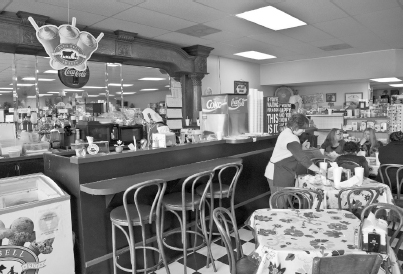
3
U.S. HIGHWAY 65
MCGEHEE
Up the road in McGehee, there are a few places worth stopping in. One of those is Kelley Drug and Selections, a local pharmacy that’s also home to a gift shop, sandwich shop and soda fountain. That soda fountain and backbar date back to another facility. The owners of Kelley Drug rescued it from another business demolition and had it restored.

The hardwood fountain backbar at Kelley Drug and Selections dates back a century. Grav Weldon.
Though not technically “classic,” Hoots BBQ deserves mention. David and Suzie Powell spent a couple years after retirement traveling from place to place by RV. When they grew tired of that, they decided to head back to their hometown of McGehee and open up a barbecue joint. The restaurant gets its name from the high school mascot, the McGehee Owl. Their eclectic tastes and nostalgic collection of restaurant items have been put to good use in decorating Hoot’s BBQ, with recycled and reclaimed décor from dozens of different locations. The barbecue is also divine. They serve great pulled pork, chopped beef, burgers and some of the best onion rings in the region.
PICKENS COMMISSARY, NEAR DUMAS
The R.A. Pickens and Son Commissary started out in 1881 as the Pickens Plantation at Walnut Lake, south of Dumas. At one point, some five hundred people were employed in the various enterprises on the land, which included everything from cotton farming and ginning to a sawmill. Today, it’s still a busy hub and home to a great southeast Arkansas restaurant and country store.
Folks around these parts call it the Commissary. Before 1948, farmers and their families would come to the commissary to purchase staples, trade and sell crops and gather to share news and enjoy a bite. There was always something to eat readily available at the counter, such as jerky or colas or fried pies.
The original structure, which bore the common general store look we’re accustomed to, burned in 1948. The building that replaced it is a long brick structure with a curved roof reminiscent of a Quonset hut. Every Monday through Friday from seven to five o’clock, the store is open. Breakfast is good, but lunch is better. The baked chicken, covered in herbs and spices, is a particularly fantastic standout. Others are just as well loved, including the meatloaf and the fried salmon patty. Then there are all the side items—regional favorites like turnip greens, sweet potatoes, broccoli-and-cheese casserole, stewed squash, rice and gravy, deviled eggs, stewed cabbage and lima beans and best of all is the squash casserole. You order at the counter and then go claim a table and get your condiments. They’ll call your name when your food is ready, you go get it and you eat it at a table in the middle of a room running all sorts of businesses around its edges—grocery store, apparel shop, post office and community center; at one time, there was even a bank. The conversations can get loud but never mean, and the clientele comes from every walk of life.
On any given day, there are coconut and chocolate meringue pies. Some days there will be peach pie, others strawberry (topped with whipped cream). Really, it’s whatever is available at the time.
These days, the folks at Pickens keep a banner-clad trailer out by U.S. Highway 65 pointing the way to the community about a mile off the road. Most travelers whiz on by, never knowing what they’re passing up. Now you know better.
PIC-NIC-KER DRIVE IN, DUMAS
If you’re a Dumas resident, you probably have had a burger at the Pic-Nic-Ker Drive In. The tiny, brown box on the corner of Waterman and Cherry Streets is the work of Mary Jenkins. She saw a need—a whole side of the town where there wasn’t a place to eat—and started up the Pic-Nic-Ker Drive In on July 4, 1974. Forty years later, the little brown building where Arkansas Highway 54 makes a hard right is still hopping.
“I have some of my family that helps me out from time to time,” Jenkins told me, “but I’m in here every day myself, doing my own cooking. It’s a hobby of mine.”
Every day, Jenkins comes in to cook, preparing Polish (fat sausages on buns), burgers and barbecue. In the summertime, kids ride their bikes over for ice cream.
When the restaurant opened, there were just two other fast food establishments in town (Big Banjo is one of them), and both were out by U.S. Highway 65. Today, most of the restaurants in town line that street, but the Pic-Nic-Ker keeps on going, the heart of a neighborhood that thrives on the little brown shop.
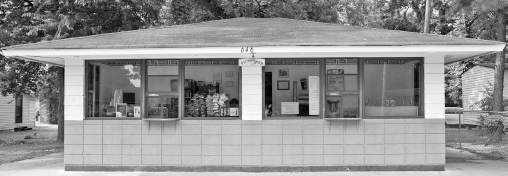
The Pic-Nic-Ker in downtown McGehee. Grav Weldon.
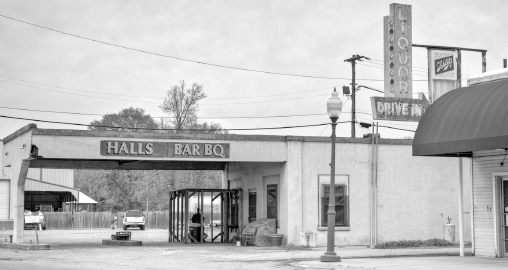
For barbecue, you go to Hall’s BBQ. Open since 1989, it’s become a Main Street community standard—but if you haven’t lived in town and you don’t know someone from the area, you may have never have heard of it. Grav Weldon.
TAYLOR’S GROCERY/TAYLOR’S STEAKHOUSE, DUMAS
A lot of folks know about Taylor’s Grocery in Mississippi—a rather famous grocery store that’s now a marvelous catfish restaurant. Did you know there’s a Taylor’s just outside of Dumas? Both are locations where groceries were once sold that now house great restaurants.
Charles and Dorothy Taylor opened Taylor’s Grocery in 1954. The original shotgun-style country house was pretty small, but it functioned like a traditional country store, a place to buy dry goods and foods and share a little gossip. In 1961, the Taylors moved the operation one-quarter mile closer to town into a larger building. They sold that store in the 1970s and opened up a third spot; in 1983, the fourth move happened, placing the business where it is now, far from the outskirts of Dumas.
Now, I mentioned grocery store. This book is all about restaurants (though later over on page 141 we’ll dive into the history of the Hays Supermarket chain), but Taylor’s was always a place to get a bite. Country stores often had a back counter and a kitchen, and you could pick up a sandwich to take with you when you picked up your bait for fishing or were heading out to the farm.
The 1983 opening of Taylor’s included not only groceries but also sporting goods, bait, tackle and just about everything for living in rural Arkansas. It did so well that Chuck Taylor (Charles’s son, who had by this time been working the grocery store for quite a while) opened a liquor store adjacent to Taylor’s (local ordinances did not allow liquor stores and grocery stores to share the same building).
“My mother has always made barbecue. We’ve always done barbecue,” Chuck Taylor told me. “You know, when the grocery store sales declined, we branched out and bought equipment and started doing hamburgers and po’ boys and the lunch thing, sandwiches and fried fish, shrimp, oysters. Then it started to grow, so we started taking out grocery shelves, taking out sporting goods and adding tables and chairs for people to eat.”
That little spot on the road from Dumas to Monticello started to pick up steam.
“We started out with two tables, and lunch just took over. We became full of tables. We still sold chips and drinks and stuff like that, knick-knacks,” said Chuck. In fact, Taylor’s cheese dip took on a great deal of notoriety, with people dropping by to pick up dip to take home. The restaurant even developed a big burger called the Double Bertha, which folks would try to eat in one setting.
But burgers weren’t where the Taylors wanted to stop. Chuck and his wife, Pam, had plans.
It’s always been our ambition to do a nighttime restaurant. So we started planning on it. We have a daughter in college now. We wanted to get her out of high school because she had activities at school—she was a majorette and we went to all the football games. We kinda held onto the lunch thing until we got her graduated. I perfected my recipes the whole time, for porterhouse steak, crawfish enchiladas, the whole time we knew we were going to do this.
Once we got her graduated, we let the liquor store license expire and took in the liquor store as part of the restaurant. We connected the two buildings, remodeled and started doing the night thing [in October 2012].
Chuck Taylor had worked out his dry-aging process over the years. While he’d always worked with the grocery and liquor stores, he made a living by supplementing with other jobs—as a cook in a duck lodge during fall and winter and surveying rice levies in spring and summer. “I started aging beef on a commercial scale when I worked a year at the Yellow Dog Lodge,” Chuck shared, “I studied up on that while I was doing lunch, too. I got that perfected, I hope.”
Taylor’s steaks have quickly gained renown, not only for their flavor but also for their size. Kansas bone-in ribeyes and T-bone steaks run twenty-five to twenty-eight ounces. There’s also a thirty-one- to thirty-five-ounce porterhouse steak for two. Once the day’s supply is gone, they’re out. There are other great dishes, such as that crawfish enchilada plate and two different lush versions of bread pudding. Of course, there’s the cheese dip, too. “Our cheese dip is legendary. That’s one of our claims to fame.”
How does an upscale restaurant manage to make it in deep, rural Arkansas?
Anytime you step out of the loop of interest, as I told my wife Pam, you realize that you had to draw from a lot of different areas. You can’t just make it on Dumas. The food has to be excellent. And it is, and we draw from everywhere—Little Rock, Texarkana, Mississippi, Fayetteville. The Panola people have come up from Louisiana. We’ve had a Saturday night where everyone in here was from DeWitt or Stuttgart. Pine Bluff, Monticello—you name it, people come, they love it, they say, “We will be back.” That one person might tell ten people, and they come and they go tell ten people. Kinda like a chain letter, word of mouth is the best thing there is.
“It’s kinda like Field of Dreams,” Chuck told me, referencing the movie. “You build it, they will come. Yeah, it’s a dream of mine to do this, but it might become a nightmare, too.” He laughed at that. Something tells me with the great product he has and this growing restaurant, Chuck Taylor is going to be laughing all the way to the bank.
HARDIN FARMS, GRADY
I am glad that Hardin Farms and Market Too is located close to Little Rock in Scott, but the quiet old place in Grady seems a bit sad. It was once a lively location, with nearly year-round farm activities. Cars once filled the parking lot and lined U.S. Highway 65 at the old family farmstead.
It probably wasn’t what Thomas Jefferson Hardin envisioned when he started the family farm in the nineteenth century. Back then, land around Grady was deeply forested in cypress, and it sold for just twenty cents an acre. T.J. Hardin’s first business venture was taking in two hundred acres, then four hundred, and harvesting what happened to already be there. From there, he turned to cotton. He also turned to raising a family of five children. After his death, his wife, Betty, kept amassing more land and growing the farm.
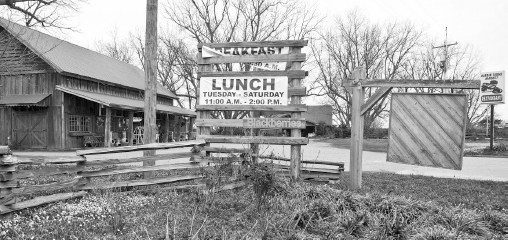
Hardin Farms in Grady. Grav Weldon.
Over the generations, the farm changed. In the 1940s, it was split between two brothers—one who embraced the mechanization of farm activity and the new chemicals and fertilizers available, the other who kept the old practices, crop rotation and hand-picking. Despite fire, drought and every other imaginable type of agricultural catastrophe, Hardin Farms continued to survive.
In the 1990s, Randy Hardin started planting cantaloupes, watermelons and pumpkins. One day, his daughter’s daycare came out to see the pumpkin patch and pick their own. Seeing all the fun they were having gave him an idea. He started cutting a maze in the cornfield after the ears were harvested. Fresh produce and pecans were available for purchase. Soon, the farm was open for folks to stop by, experience life in the rural Delta and have a bite to eat. It became the site for an annual pilgrimage for city families wanting to share their agricultural background with their young. It also became a must-stop for travelers passing through southeast Arkansas.
Sadly, progress got in the way of that. In 2011, a bypass of Grady cut the farm in twain, and Hardin decided it wasn’t safe to send kids across the new four-lane highway in wagons any more. The attraction was closed, and though the farms still produce, there’s no stop at which to pick up vittles and no corn mazes to hide in any more. Grady itself has all but dried up, with the closing of its school and most of its population depleted.
However, on the third Thursday in August, there’s a gathering that still brings the town to life. Politicians, food lovers and folks who trace their ancestry to this Delta flat come to the annual Grady Fish Fry, hosted by the Lions Club as its major annual fundraiser. Approximately 1,400 tickets are sold each year. A dinner of fried catfish, hush puppies, French fries and watermelon is served under the sprawling old pecan trees in the Hardin yard. The Hardins even have a hush puppy machine, which tends to fascinate the Yankees.
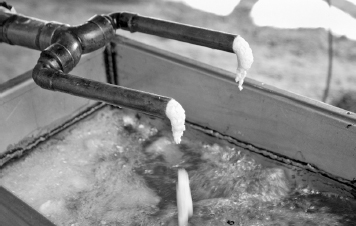
The late M.E. Argo, a machinist and Grady Lions Club member, made the hush puppy machine in his welding shop more than a half century ago. The contraption, only used at the Grady Fish Fry, spits two dollops at a time into the hot grease. Kat Robinson.
The Hardin clan is still working hard to preserve farm life. Later on, I’ll tell you what the Hardins are doing today in the community of Scott and the brother who’s doing what he can to save farm life in the Delta.
THE LAST STRETCH TO PINE BLUFF
North on U.S. Highway 65, you start noticing more trees on the horizon to your left. The edges of Bayou Bartholomew demarcate the edge of the Delta and the start of the Timberlands. To the right, ponds and pools can be seen here and there; the Arkansas River is just over the levee in the distance.
Past Moscow and Noble Lake, you come to the southeastern edge of Pine Bluff. At the intersection of U.S. Highway 65 and Arkansas Highway 81, there’s a long white building to the right. The east end is a convenience store; the west end is a restaurant that’s survived more than sixty-five years.
Lavender’s Barn began right after World War II, when a serviceman returning from overseas needed a new career. The restaurant was purchased and food was served. Not much has changed, though the décor was updated in the 1970s and seating seems to have been obtained from former fast-food restaurants. This is still a solid stop for patty melts, burgers, breakfasts and pie.